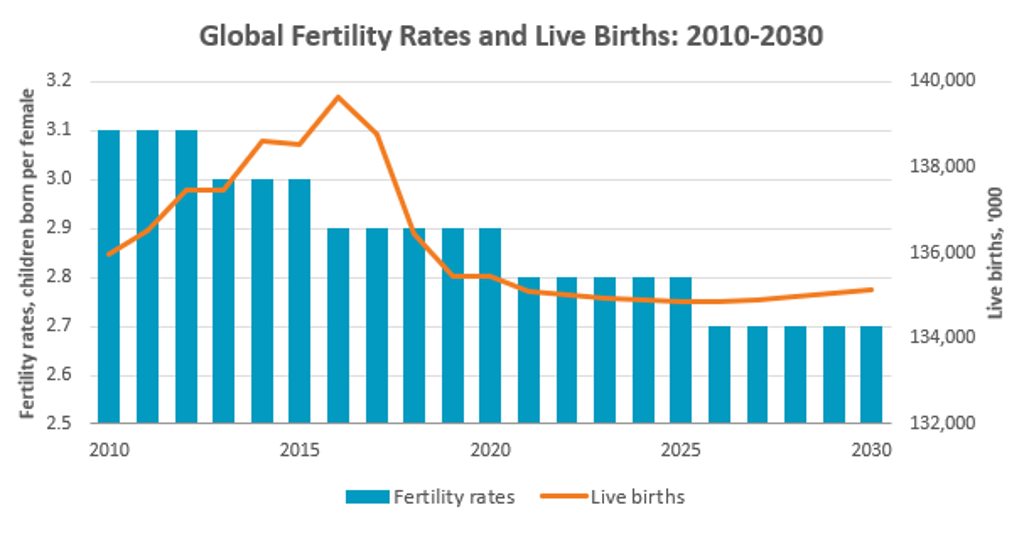Lockdown measures across the world following the outbreak of Coronavirus (COVID-19) have prompted speculation of a prospective baby boom, given the necessity of home seclusion and the temporary cessation of other conventional forms of entertainment. However, the prospect of a global economic recession, expected to be the worst since the Great Depression, makes the prospect of a baby boom considerably less likely.
Knowing the contextual effects of COVID-19 on birth rates is important for the business strategies of companies operating in child-related areas, as well as for governments and economies across the globe, given the impact that population growth has on the rate of population ageing and economic growth potential.
The hidden impact of COVID-19 on fertility rates
Factors influencing childbirth and fertility rates are various, ranging from the age structure, particularly the female population in reproductive age (15-49), to socioeconomic changes. Before the pandemic, the global fertility rate had been in decline, mainly due to rising living standards, higher female participation in the workforce and urbanisation leading to lifestyles changes.
Source: Euromonitor International from UN/Eurostat/World Bank/national statistics. Note: Data from 2020 are forecasts.
Now the economic and social changes triggered by COVID-19 are impacting a wide range of factors that are likely to influence childbearing intentions and fertility rates, such as human interaction, health, family income, migration flows and access to contraception. Although ongoing uncertainties make it difficult to make precise predictions, there will be up to 330,000 fewer new births globally in 2021, bringing the global fertility rate down to 2.8 children born per female in the same year.
The impact of COVID-19 on childbirth and fertility rates, however, varies across countries and regions, as well as between developed and developing countries. Developed countries will experience a further drop in new births in 2020-2021, while in developing markets, the impact of COVID-19 on fertility rates depends on urbanisation and income levels.
Developed economies are expected to see a decline in childbirth
As the younger generations (specifically millennials and Generation Z) in developed markets are facing bleak economic and job prospects amidst the pandemic, it is likely they will postpone or reconsider marriage and childbirth. Historic experiences show similar patterns, with births declining faster during an economic recession. In the aftermath of the 2008 global financial crisis, for example, the number of new births in the US dropped by 2.8% in 2009 and 3.2% in 2010.
Source: Euromonitor International from UN/Eurostat/World Bank/national statistics. Note: Data are forecasts.
Though fertility rates and new births had already declined across most developed countries even before the pandemic, further drops are expected for the next two years. Overall, a stronger feeling of uncertainty will make couples in high-income countries postpone any long-term investments including raising children, thus reducing fertility rates further.
Italy is forecast to see a notable dip in childbirths in 2020 and 2021, as families and young people in the country face significant income shocks caused by a steep economic recession (11% GDP decline in 2020) and high unemployment (10% in 2020). In the US, apart from the impact of the economic recession, new births will also be affected by a sharp decline in immigration in 2020.
A further fertility fall in high-income countries would accelerate population ageing and population decline, both of which are already major concerns which undermine growth potential in these economies. With fewer children being born during the recession, the demand for baby-related products and services in developed markets could remain sluggish in the short and medium-term.
Developing countries may see mixed impacts
In low- and middle-income countries, economic development and urbanisation have been important factors, bringing the fertility rate down from 3.6 children born per female in 2000 to 3.0 in 2019. Now that economies fall into recession and rural-urban migration is disrupted due to lockdown, this trend is likely to continue, given the mixed impact COVID-19 may have on fertility rates in rural areas compared to urban.
In rural areas, rising poverty may prevent some young people from pursuing education and force them to get married, which typically leads to an increase in childbirths. In some regions, as family planning centres were forced to close during the pandemic, a lack of access to contraception will also have accelerated fertility rates.
On the other hand, in developing and emerging cities, as urban dwellers are more vulnerable to job loss and declining income during COVID-19 and child-raising costs are relatively high, couples are less likely to decide to have children amidst economic uncertainties. Considering these different effects, it is expected that the fertility rate in developing and emerging markets will remain at 3.0 children per female in 2020 before it starts to fall again to 2.9 in 2021.
With no doubt, COVID-19 has impacted the global population, as mortality rates escalate and the socioeconomic changes triggered by the pandemic are likely to influence child-bearing patterns, leading to changes in fertility rates at both national and global levels in 2020-2021. In the long term, as the global population is ageing, falling birth rates and shrinking household sizes will continue to shape family and consumer demand, requiring businesses to adapt.


